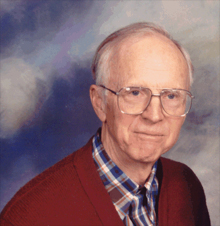Dr. James W. Deardorff
In the article ET Visitors: Scientists See High Likelihood, SPACE.com reported
“Decades ago, it was physicist Enrico Fermi who pondered the issue of extraterrestrial civilizations with fellow theorists over lunch, generating the famous quip: ‘Where are they?’ That question later became central to debates about the cosmological census count of other star folk and possible extraterrestrial (ET) visitors from afar.James W. Deardorff, Ph.D., FAMS, FAAAS was the lead author of this article in JBIS and is Professor Emeritus at Oregon State University. He received a B.S. in Physics from Stanford University in 1950, a B.S. in Meteorology from University of California at Los Angeles in 1951, a M.S. in Meteorology from University of Washington in 1956 and a Ph.D. in Meteorology from University of Washington in 1959.Fermi’s brooding on the topic was later labeled ‘Fermi’s paradox’. It is a well-traveled tale from the 1950’s when the scientist broached the subject in discussions with colleagues in Los Alamos, New Mexico. Thoughts regarding the probability of earthlike planets, the rise of highly advanced civilizations ‘out there’, and interstellar travel — these remain fodder for trying to respond to Fermi’s paradox even today.
Now a team of American scientists note that recent astrophysical discoveries suggest that we should find ourselves in the midst of one or more extraterrestrial civilizations… In their proposal in the January/February 2005 issue of the Journal of the British Interplanetary Society (JBIS), the scientists point to two key discoveries made by Australian astronomers and reported last year that there is a ‘galactic habitable zone’ in our Milky Way Galaxy. And more importantly that Earth’s own star, the Sun, is relatively young in comparison to the average star in this zone — by as much as a billion years.”
Jim has been elected a Fellow of the American Meteorological Society and a Fellow of the American Association for the Advancement of Science. He was honored with the Rossby Research Medal by the American Meteorological Society in 1978.
Jim has authored or coauthored over a hundred publications since 1958 including On the stability of viscous plane Couette flow in The Journal of Fluid Mechanics, Preliminary results from numerical integrations of the unstable planetary boundary layer in Journal of the Atmospheric Sciences, Computer and laboratory modeling of the vertical diffusion of non-buoyant particles in a mixed layer in Advances in Geophysics, and Possible extraterrestrial strategy for Earth in Quarterly Journal of the Royal Astronomical Society. His books include Jesus in India and The Problems of New Testament Gospel Origins: A Glasnost Approach.
